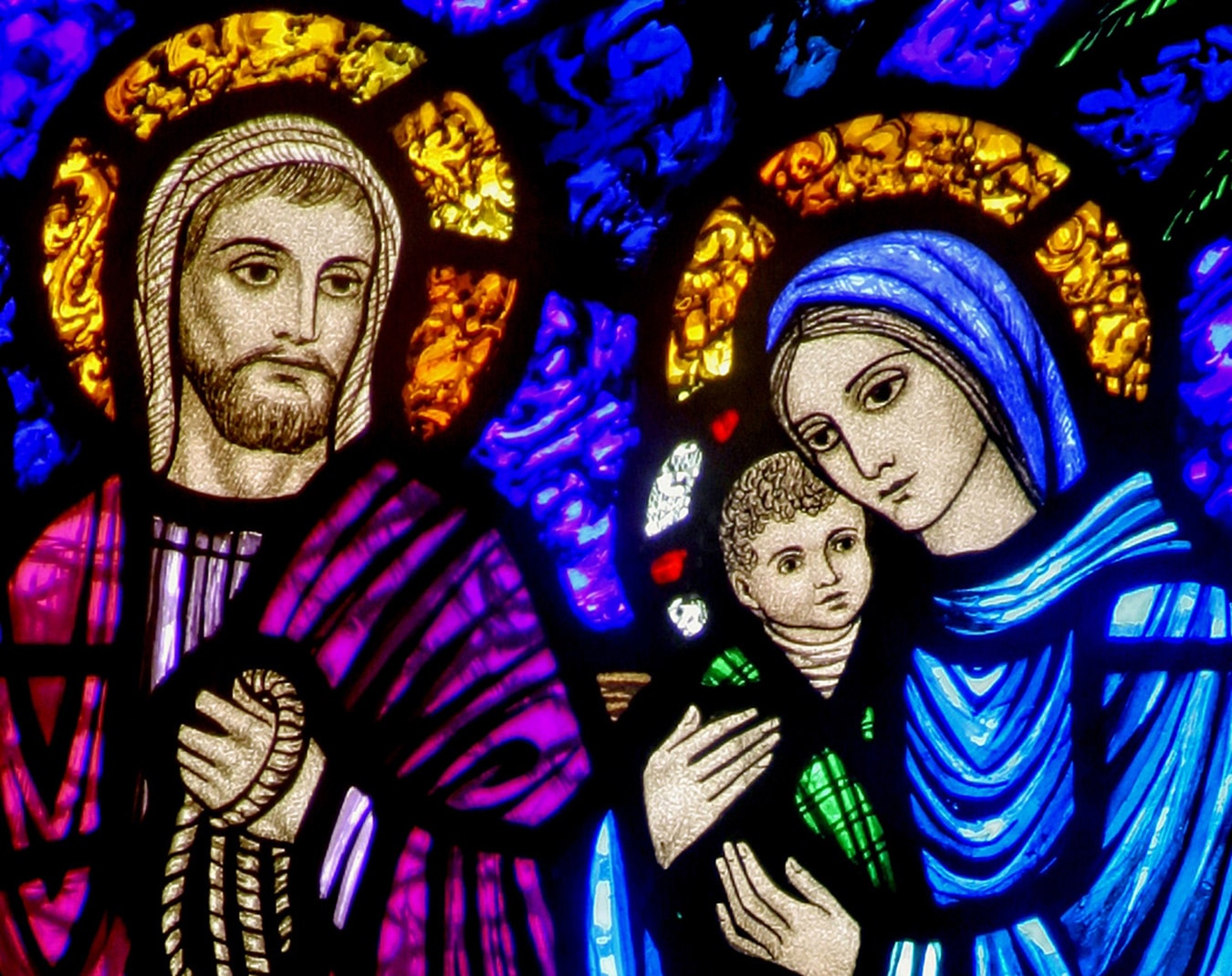“Do your best to present yourself to God as one approved,” St. Paul instructed his protégé, St. Timothy, “a workman who has no need to be ashamed, rightly handling the word of truth” (2 Tim 2:15). Study of the sacred tradition of the Church, including the tradition that has been recorded in sacred Scripture, is central to obeying this admonition. This is because “the word of God is living and active, sharper than any two-edged sword,” the author of the Letter to the Hebrews reminds us, “piercing to the division of soul and spirit, of joints and marrow, and discerning the thoughts and intentions of the heart” (Heb 4:12).
Both these passages came to mind as I began to peruse the complete Ignatius Catholic Study Bible, newly published by Ignatius Press. More than 25 years in the making, the Bible is a labor of love and determination. Under the vision and guidance of Jesuit Father Joseph Fessio, principal editors Scott Hahn and Curtis Mitch gathered a team of theologians and biblical scholars to produce the definitive study Bible for Catholics. Which is to say that the Ignatius Bible is not a generic study Bible. Rather, the Ignatius Bible has been produced by Catholic scholars for Catholic Christians.
For more than 30 years, the most prominent study Bible in university and seminary classrooms, as well as Catholic homes, has probably been the Catholic Study Bible from Oxford University Press. Using the New American Bible Revised Edition translation (which is also used in the American missal and lectionary), the Oxford Bible is noteworthy for its careful scholarship and attention to detail. What it has always lacked, however, is commentary and explanatory notes by Catholic scholars for a Catholic audience. It is “Catholic” only because it includes the books of the Old Testament that were excluded from the canon by leaders of the Protestant schism. The Oxford Bible’s lack of a distinctly Catholic approach to some controversial passages has always been a shortcoming. In its commentary, Catholics are referred to in the third person to note what “they” believe about certain passages. The comments do not defend the Church’s interpretations of those passages, only distinguish them from the implicitly “proper” non-Catholic understanding.
The Ignatius Bible, which uses the Revised Standard Version translation, remedies that situation. Contrasting the commentary on three key sections of Scripture illustrates my point.
Purgatory and the Communion of Saints
Scriptural support for the Catholic doctrine of purgatory, as well as prayers to and for the faithful departed, is found in Chapters 12 and 15 of 2 Maccabees. Commenting on the key verses, the Oxford Bible simply says that 2 Maccabees 12:44-45 indicates the “belief” of the author, not the truth of revelation. “This belief is similar to, but not quite the same as, the Catholic doctrine of purgatory,” the commentary asserts. Similarly, the note on 2 Maccabees 15:14 in the Oxford Bible observes that “prayer in heaven has been taken in the Roman Catholic tradition as a biblical witness to the intercession of the saints.”
In contrast, the comments on these two passages in the Ignatius Bible provide a confessional explanation of the Church’s authoritative interpretation of them. Commenting on 2 Maccabees 12:44-45, the note recounts the ancient tradition of prayers for the dead, drawing upon St. Augustine’s treatise “On the Care of the Dead.” And the Ignatius Bible commentary points out the witness of St. Perpetua, who commends prayer for the faithful departed as a well-established doctrine by the beginning of the third century. Similarly, the annotation to 2 Maccabees 15:14 invokes Origen of Alexandria as authority for the ancient doctrine of the communion of saints, including those who have preceded us in death.
The Immaculate Conception of the Blessed Virgin Mary
In Luke 1:28, the archangel Gabriel greets St. Mary to announce that she would bear the Savior. While the Revised Standard Version translation uses the phrase “O favored one” in St. Gabriel’s greeting, the Ignatius Bible deviates from the RSV by translating the Greek word “kecharitomene” as “full of grace.” This, the note explains, is more faithful to the rich meaning of the Greek term, indicating that God “has already ‘graced’ Mary,” filling her with “divine life.” While “favored one” is not an inaccurate translation, the note explains, it does not capture the full theological import of the Greek word, from which the doctrine of the Immaculate Conception is developed. In contrast, the explanatory note in the Oxford Bible is silent about the meaning of the term, settling for the New American Bible’s rendering of “Hail, favored one.” Rather than account for the Catholic (and thus historical) interpretation of “kecharitomene,” the Oxford Bible’s editors punt.
The Real Presence of Jesus in the Eucharist
Finally, the Ignatius Bible accounts for the authentic meaning of the “Bread of Life” discourse in the Chapter 6 of the Gospel of John. This contrasts with the Oxford Bible, which implicitly denies the doctrine of the real presence and deflects the incredulous reaction of the crowd. The note in the Ignatius Bible explains that “Jesus is speaking literally and sacramentally” in John 6:53 when he declares, “Truly, truly, I say to you, unless you eat the flesh of the Son of man and drink his blood, you have no life in you.” If Jesus had meant his words to be taken metaphorically, the commentary explains, he would have used a familiar Hebrew idiom that would have been readily understood by his audience. To drive home the point, the Ignatius Bible includes a short study of the Greek word “trogo,” in verses 54 and 56-58, meaning to “gnaw” or “chew.” This is different from the more common Greek word for eating, which Jesus uses in John 6 prior to verses 54-58.
The Oxford Bible, in contrast, downplays the significance of the verb “trogo,” simply declaring that it “may be part of John’s emphasis on the reality of the flesh and blood of Jesus,” but also became the “ordinary verb” in Greek meaning to eat. This deflection of the Eucharistic theology of John 6 is further emphasized in the Oxford Bible’s treatment of John 6:60, where Jesus’ audience said, “This is a hard saying; who can listen to it?” The obvious antecedent to “this … hard saying” is the declaration Jesus has just made that one must eat his flesh and drink his blood. However, the Oxford Bible note tendentiously declares that John 6:60 is not referring to the immediately preceding discourse, but rather to the themes of John 6:35-50. Jesus’ auditors “found it difficult to accept the high Christology” of the prior verses. This editorial decision is an implicit denial of the only reasonable interpretation of John 6:52-58, namely that Jesus meant one must eat his true body and blood.
Of course, these are just a handful of examples of the sound, careful explanatory notes in the Ignatius Bible, which should become the new go-to study Bible for Catholics. Coming in at more than 2,300 pages, the Bible is chock full of maps, graphs, charts, timelines, indexes, cross references and explanatory essays. Taken together, these constitute an attempt to “think with the Church,” in the words of St. Ignatius of Loyola. What could be more appropriate for the Ignatius Catholic Study Bible?








